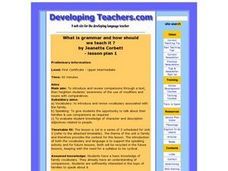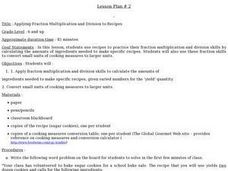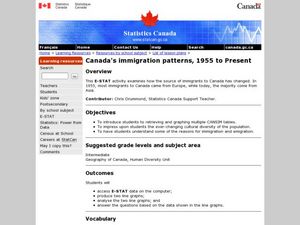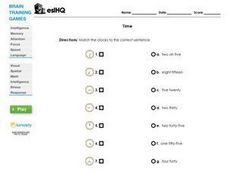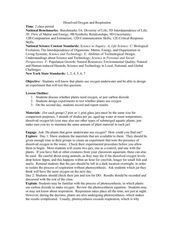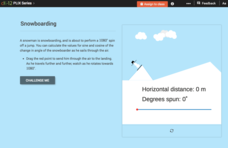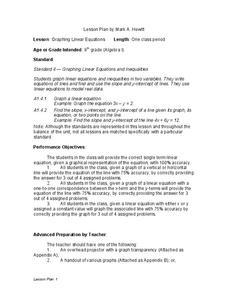Curated OER
Using the Internet to Learn the Internet
Seventh graders investigate the key terms and concepts of the Internet. The explore web pages to define the terms and concepts and word process to design an assessment which becomes a reference sheet.
Curated OER
What is Grammar and How Should We Teach It?
Young scholars review comparisons through a text, to heighten student's awareness of the use of modifiers and nouns with comparatives.
Curated OER
How does Your Province Stack Up?
Students investigate data about age, and sex of a population. In this statistics lesson, students are given data on a population to analyze and compare to other provinces. This assignment is part of a geography lesson and requires 3...
Curated OER
Applying Fraction Multiplication and Division to Recipes
Students use recipes to practice their fraction multiplication and division skills by calculating the amounts of ingredients needed to make specific recipes. They use these fraction skills to convert small units of cooking measures to...
Curated OER
Using Pictures and Slogans to Persuade an Audience!
Middle schoolers discuss how writers use various techniques to persuade an audience and examine examples used in the media. They interpret their thoughts and feelings about pictures, symbols and slogans and create an advertisement using...
Curated OER
Introduction To Melodic Notation: Sol-Mi
Second graders discover the use of melody in music and how it relates to simple songs and music notation. Students sing and move throughout this lesson. Emphasis is placed upon group and individual practice interpreting musical melodies.
Curated OER
Introduction to Estimation and Making Arrays
Students explore the concept of estimating and organizing a group of objects into an array to count the exact number of items. They create their own arrays and practice elements of estimation.
Curated OER
Intro To Probability
Students investigate the concepts related to the practice of using probability. They review the use of mean, median, and mode within the context of previous instruction. Students predict outcomes and calculate them in small groups. The...
Curated OER
Canada's Immigration patterns: 1950 to Present
Students examine the changing immigration pattern of Canada. For this immigration lesson, students use statistical data from a web-site to complete a worksheet and graph their findings.
Curated OER
#22c Airplane flight #22d Airplane flight--How High? How Fast?
Students discuss the application of frames of reference to an airplane flying with a constant velocity v through the air.
Curated OER
Match the Clocks to the Correct Time
In this telling time worksheet, learners analyze the time on 7 clocks and match them with the correct time which is expressed in words. Times are to the nearest five minutes.
Curated OER
What Are The Properties of Sea Water?
Ninth graders conduct research on the subject of sea water. They use a variety of resources to obtain information. There are helpful resource links listed in the activity. In conjunction with the research students make inquiry of the...
NOAA
The Biggest Plates on Earth
The deepest part of the ocean is the Marianas trench where two tectonic plates meet. Scholars explore plate tectonics and their boundary types by completing hands-on activities throughout the lesson. Specific areas, such as the Galapagos...
Inside Mathematics
Party
Thirty at the party won't cost any more than twenty-five. The assessment task provides a scenario for the cost of a party where the initial fee covers a given number of guests. The class determines the cost for specific numbers of guests...
Premier Literacy
Point of View
Incorporate technology into a literature lesson with an innovative language arts lesson. Middle schoolers read an electronic version of original stories or fairy tales, and after determining the point of view, rewrite the tale from...
Cornell University
Making a Battery
Don't be shocked when your class has a blast making their own batteries! Science scholars examine a dry cell battery, then design and construct a wet cell battery. The activity guides them through the parts of a battery, the variables...
Cornell University
The Galvanic Cell Game
Play a little game with your classes! Young scholars expand on their understanding of oxidation/reduction reactions in a game-based activity. They build a Galvanic cell with game pieces while learning about each component and their...
Curated OER
Dissolved Oxygen and Respiration
Students are presented with the question, "Do plants that grow underwater use oxygen?" They create an experiment to test the presence of dissolved oxygen in the water using provided materials. Student experiments include a control jar as...
Visa
In Trouble
What are some of the financial risks associated with using credit? Pupils learn the warning signs of incurring financial hardship, and through PowerPoint presentations, worksheets, and discussion, discover the...
Curated OER
Change Since 1609
Students recognize how the climate of the Hudson Valley has changed since the last glaciation. They explain these changes using a reconstruction of the land use changes in the Hudson Valley composed of confetti, Ziploc bags and other...
Curated OER
Paleoclimate of the Hudson Valley
Students recognize how the climate of the Hudson Valley has changed since the last glaciation and be able to explain these changes. They reconstruct the paleoclimate of the Hudson Valley.
EduGAINs
Ratio and Proportion
Do these items have the same ratio? Through a learning contract, pupils master proportions by practicing proportions via word problems, graphs, and with manipulatives. An exit ticket checks for understanding at the end of the...
CK-12 Foundation
Trigonometric Functions of Angles Greater than 360 Degrees: Snowboarding
Spin through the trigonometric functions. Scholars determine the angle of rotation a snowboarding snowman makes at various distances in his jump. The class members then calculate the values of trigonometric functions for those angles.
Curated OER
Graphing Linear Equations
Ninth graders review the information that they have already learned
with regard to linear equations and graphical representations. They then assist in combining equations with a graphical element and complete various graphs with this...

